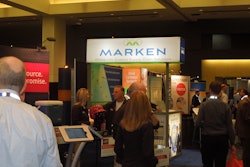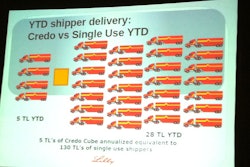Then the inevitable happens—the capital review team, whose members may not know a proximity sensor from a pressure transmitter say, “No money available.”
Keith Campbell, veteran of Hershey’s engineering management team with many years of experience justifying automation expenditures, says, “Do it in their language, it’s easier to convince them.”
Shrewd managers make capital decisions based on return on investment. You have to show them how your project will impact the bottome line. If you can’t show the monetary justification in the language of finance, you’ll never convince them.
Different languages
This language has terms like cash flow, capital and interest. Campbell, who reveals these definitions later, advises, “You must identify the positive cash flows you create with a new system, and then, using your company’s method for calculating cash flow, do the math.”
Even if we are on a solid footing with the language of finance, we may not be so good at seeing our projects through an investor’s careful eyes. Peter Martin, vice president of Invensys, a Foxborough, Mass., supplier of process controls and software, says, “When you are justifying automation, it’s important to remember that it’s an accounting problem. It is possible to solve the accounting problem through engineering principles, however. For instance, where is the biggest cost accounting database in manufacturing? It is information from all the sensors in the production process.” In other words, tap into the data you have, and translate them into financial numbers. (See Chapter 3 which discusses use of familiar units when stating OEE results. It’s an easy step to move from units to unit cost, for example).
Technical managers may be sitting on a gold mine of cost detail that can be used to determine where the manufacturing problems lie, as well as the crucial data that can be used to figure out the best solution—and how to get through the financial maze to approval.
This advice directly leads to the conclusion that bringing a finance person into the automation buying team will reap huge rewards at the justification stage. This person would be involved in the analysis at all stages of the project, and will be well positioned to translate benefits into the correct numbers.
Why is there such an emphasis on financial analysis these days? Steve Loranger, area vice president for Emerson Process Management, an Austin, Texas-based process controls supplier, notes the changing value of automation over the last 25 years. “Automation drivers from the 1950s to 1975 went from pneumatics to electronics by emphasizing speed of operation and labor improvements with limited automation improvements. Drivers from 1975 to 2000 were repeatability and quality. During this time, computers went mainstream, there was improved control and information integration became essential. Now, drivers are economics and business optimization, due to globally integrated manufacturing and activity-based cost accounting.”
A new automation project can be designed to solve any of a number of problems in the plant. The sidebar accompanying this article provides several areas of improvement that can result from the project. Some of the areas can be hard to quantify, but it is essential to try to cost-justify as many as possible.
For example, it may seem hard to quantify safety and ergonomic improvements that result from improved automation. But safety and insurance experts may be able to help document savings that can include anything from avoiding lost work-days to lower insurance premiums. Boston-based Liberty Mutual released its 2003 Fall Workplace Safety Index, and concluded that the financial impact of workplace injuries in the United States is growing faster than the rate of inflation.
Insurance premium savings are certainly welcome, but a greater value to an inverstor is reducing risk to future earnings. Failure Mode Effect and Criticality Analysis is a powerful tool that can be used to demonstrate the risk of a catastrophic safety event involving loss of life or limb. More often than not, risk elimination will strengthen the case for capital approval.
Lifecycle costs
Bill Egert, engineering vice president of Addison, Ill.-based integrator Logic One Consulting, and member of the Board of Advisors for the Robotics International division of the Society of Manufacturing Engineers, advises calculating all of the costs associated with the life cycle of machines. He notes, “Check out costs associated with changes. For instance, on robotics, evaluate the tooling changes needed to support product changeover plus auxiliary equipment such as feeders, conveyors and workstations associated with material handling.”
Don’t dismiss employee turnover or morale as a factor that can’t be quantified. Egert reveals, “We had a printed circuit board assembly machine with robots where the component lead straightness was specified. But the manufacturing of one of the components, a relay, was sent to Mexico in order to save costs. Constant employee turnover in that plant caused quality problems including solder buildup or tape missing over a hole. The problems just couldn’t be controlled.”
This organization clearly suffered because the decision to source in Mexico did not take into account quality tolerances. Compounding the problem, operations and finance folks couldn’t team up to demonstrate the cash impact of the scrap and productivity loss.
Justification is technology independent. The same rules apply to buildings, automation systems and computer systems, and to various scopes such as the entire project, just a portion of a project or even when evaluating competing quotes.
Campbell says the fundamentals of justification include these steps:
• Identify the base case
• Identify alternatives to the base case
• Determine cash flows associated with the alternatives vs. the base case
• Use your company’s financial rules to evaluate the alternatives (payback period, net present value, rate of return, hurdle rate).
The base case is the current state of affairs. Include all the financial data that can be compiled. Then, having identified the correctable problems, document various alternatives to the base case.
Quantify all the risk, benefit and loss factors that you can. Take a balanced approach addressing significant pros and cons to demonstrate your thoughtfulness and enhance your credibility. Calculate the numbers and compare to the company’s financial rules. Those results can then be compared to determine the best alternative to present to management for funding.
Because projects are expected to pay back funds over several years, it is important to find a way to normalize the amounts in order to keep the analysis in proper perspective.
Present value
The first step is to determine the present value, which is defined as the value of all future cash flows discounted at the cost of capital, minus the cost of the investment. Discounted means that a future cash flow is worth less (discounted) than a present cash flow.
So, $100 received three years from now at 8% cost of capital is the same as receiving $79.38 today.
The Net Present Value (NPV) is the present value of all future cash flows discounted at the cost of capital, minus the cost of investment. Cost of capital is a weighted combination of the cost of debt (long term debt and leases after tax) and the cost of equity (preferred and common stock). All future cash flows means that the PVs are summed over some time horizon, often 5 or 10 years. Subtract the cost of the initial investment from the sum of the PVs to get NPV. The greater the NPV, the better the investment.
What if the company just took the funds and invested them? A valuable comparison is the return due to the business investment versus an anticipated return from automation project investments. The Internal Rate of Return (IRR) is the interest rate that equates the present value of future cash flows to the investment outlay. The IRR assumes that cash flows can be reinvested at a rate equal to the IRR.
The hurdle rate is the minimum rate of return to justify an investment. This includes cost of capital, risk premium (which will include analysis of the track record of the group asking for money, type of investment and allowance for overruns), and other factors such as working capital requirements.
Calculate the cash flows and rates of return for all of the alternatives and then the best solutions will pop out. If the numbers don’t make the hurdle rate, then re-evaluate the benefits. (Microsoft® Excel® has functions that easily calculate NPV as well as payback and IRR justifications).
Emerson’s Loranger discusses the analysis from a slightly different point of view. See the graphic “Connecting The Balance Sheet And The Income Statement.” The balance sheet is where assets and liabilities are tabulated and the income statement is where income and expenses are calculated. The analysis entails comparing the Return on Invested Capital (operating earnings from income statement divded by invested capital shown on balance sheet) to the weighted average cost of capital, or hurdle rate. The difference is the economic value added.
Analysis is good, but often engineers looking at automation projects become infatuated with new technologies and fail to match the project up with business strategies. As Loranger shows in the Business Planning Framework graphic, technology managers find their comfort zones in evaluating automation technology alternatives. The profit zone for the business, however, lies in meeting or exceeding plant, production and business objectives. So, when looking for projects with the highest probability of approval, make sure that they align with one or more of the objectives in the Profit Zone.
Train managers
Logic One’s Egert offers some additional tips on putting together a justification package. “Get management trained on technical aspects,” he states. “They have lots of knowledge and experience on finance and marketing, but not much on technical aspects.
A progressive, smart manager will have those technical people. A manager with technical skills will be able to see some problems coming.” Another problem is management embracing new technology with no strategy for implementing, no urgency for training or no technical champion to embrace and learn the new stuff.
It’s not just a matter of providing training in some cases, but whether the workforce has the basic background skills to make training a practical option.
One approach that might change all of the calculations would be to lease new equipment, rather than purchase it. Paul Frechette, president and chief operating officer of Key Equipment Finance, commercial leasing services, a Superior, Colo. unit of Key Corp., says, “80 percent of American businesses lease equipment. They do it understanding that it is use of equipment, not ownership, that creates profits. Leasing from the vendor or from a lessor experienced in the field often yields the best deal, because they understand the value of the residuals (the value of the equipment after the term of the lease is over). The bigger lessors have been doing this for a long time and want repeat business, so they treat the residuals well. Their goal is to become trusted advisors.”
Assistance in evaluating leasing options is available from equipment sales people. Another resource close at hand would be people in the company’s own finance department. They probably are already leasing equipment and have the process figured out.
Who are you competing with internally for dollars?
Make sure your project proposal appeals to your company’s, your business unit’s and your project stakeholder’s priorities. After all, you are competing for the same capital as everyone else. This isn’t political. This is survival. Don’t let that ‘green roof’ win over your packaging line!
• Sustainable packaging – what will really do the most to reduce your ‘total system carbon footprint?’ Will it be that green roof proposal, or your line that will run lightweighted packs with less scrap and less energy? Packaging lines won’t make the same photo opp that goats munching turf on your plant roof will – but your Chief Sustainability Officer should like your numbers better.
• Will your proposed system save water, compressed air usage, electricity, and/or floor space that must be lighted, heated and cooled? Most plants today face corporate mandates to hit reductions in all these resources, and every bit helps.
• Consider distributed drive technologies that reduce the heat buildup inside electrical cabinets and eliminate the need for costly air conditioning and filtration, along with reduced floorspace. To maximize energy efficiency, also consider high efficiency electrical power supplies, regenerative power supplies for servo drives, and a common DC bus between servo drives.
• How easily can your packaging system be reconfigured if the intended product line goes away? This is where automation can actually help the product marketers mitigate the risk of their program proposal.
• How is your company investing in growth markets? Could your automated line be readily deployed and supported worldwide with little or no modification, following international electrical and safety standards as opposed to the local site’s internal standards? That could be a big plus.
• Headcount impact – programs that increase headcount don’t fare well during a hiring freeze. Increasing capacity without increasing labor is a good justification. But automation that can efficiently scale throughput up or down with reduced attention from plant personnel sounds like a real winner.
• Don’t forget convergence (Chapter 1) of advanced technologies and best practices that have a positive impact on seemingly unrelated aspects of operations. For example, implementing integrated safety doesn’t just make a packaging line safer, it means more uptime which results in measurable Overall Equipment Effectiveness (OEE) improvements. And today, the safety network can be same network that links machinery together on a line, which also improves OEE.
Note: This article is as relevant today as it was in 2003 when first published. It has been updated with improvements from the Playbook’s editorial advisory board.
Liked this article? Download the entire playbook here.

























